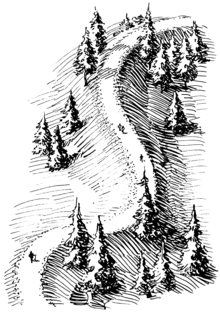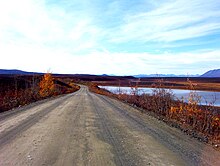Esker



Anesker,eskar,eschar,oros,sometimes called anasar,osar,orserpent kame,[1][2]is a long, windingridgeofstratifiedsandandgravel,examples of which occur inglaciatedand formerly glaciated regions of Europe and North America. Eskers are frequently several kilometres long and, because of their uniform shape, look likerailwayembankments.[3]
Etymology

The termeskeris derived from theIrishwordeiscir(Old Irish:escir), which means "ridge or elevation, especially one separating two plains or depressed surfaces".[4]The Irish word was and is used particularly to describe long sinuous ridges, which are now known to be deposits offluvio-glacialmaterial. The best-known example of such aneisciris theEiscir Riada,which runs nearly the whole width ofIrelandfromDublintoGalway,a distance of 200 km (120 mi), and is still closely followed by the main Dublin–Galway road
The synonymoscomes from the Swedish wordås,"ridge".
Geology
Most eskers are argued to have formed within ice-walled tunnels by streams that flowed within and under glaciers. They tended to form around the time of theglacial maximum,when the glacier was slow and sluggish. After the retaining ice walls melted away, stream deposits remained as long winding ridges.
Eskers may also form above glaciers by accumulation of sediment insupraglacial channels,increvasses,in linear zones between stagnant blocks, or in narrow embayments at glacier margins. Eskers form near the terminal zone of glaciers, where the ice is not moving as fast and is relatively thin.[5]

Plastic flow and melting of the basal ice determines the size and shape of the subglacial tunnel. This in turn determines the shape, composition and structure of an esker. Eskers may exist as a single channel, or may be part of a branching system withtributaryeskers. They are not often found as continuous ridges, but have gaps that separate the winding segments. The ridge crests of eskers are not usually level for very long, and are generally knobby. Eskers may be broad-crested or sharp-crested with steep sides.[5]They can reach hundreds of kilometers in length and are generally 20–30 m (66–98 ft) in height.
The path of an esker is governed by its water pressure in relation to the overlying ice. Generally, the pressure of the ice was at such a point that it would allow eskers to run in the direction of glacial flow, but force them into the lowest possible points such as valleys or river beds, which may deviate from the direct path of the glacier. This process is what produces the wide eskers upon which roads and highways can be built. Less pressure, occurring in areas closer to theglacial maximum,can cause ice to melt over the stream flow and create steep-walled, sharply-arched tunnels.[6]
The concentration of rock debris in the ice and the rate at which sediment is delivered to the tunnel by melting and from upstream transport determines the amount ofsedimentin an esker. The sediment generally consists of coarse-grained, water-laid sand and gravel, although gravelly loam may be found where the rock debris is rich in clay. This sediment is stratified and sorted, and usually consists of pebble/cobble-sized material with occasional boulders.Beddingmay be irregular but is almost always present, andcross-beddingis common.[5]
There are various cases whereinland duneshave developed next to eskers afterdeglaciation.[7]These dunes are often found in the leeward side of eskers, if the esker is not oriented parallel to prevailing winds.[7]Examples of dunes developed on eskers can be found in bothSwedishandFinnishLapland.[7][8]
Lakes may form within depressions in eskers. These lakes can lack surface outflows and inflows and have drastic fluctuations over time.[9]
Life on eskers
Eskers are critical to the ecology of Northern Canada. Several plants that grow on eskers, includingbear rootandcranberries,are important food forbearsand migrating waterfowl; animals fromgrizzly bearstotundra wolvestoground squirrelscan burrow into the eskers to survive the long winters.[10]
Examples of eskers


Europe
InSweden,Uppsalaåsenstretches for 250 km (160 mi) and passes throughUppsalacity. TheBadelundaåsenesker runs for over 300 km (190 mi) fromNyköpingto lakeSiljan.Pispala'sPyynikki EskerinTampere,Finland, is on an esker between two lakes carved byglaciers.A similar site isPunkaharjuinFinnish Lakeland.
The village ofKemnayin Aberdeenshire, Scotland has a 5 km (3.1 mi) esker locally called the Kemb Hills. InBerwickshirein southeast Scotland is Bedshiel Kaims, a 3 km-long (1.9 mi) example which is up to 15 m (49 ft) high and is a legacy of an ice-stream within theTweed Valley.[11]
North America
Great Esker Parkruns along the Back River inWeymouth, Massachusetts,and is home to the highest esker in North America (27 m (90 ft)).[12]
There are over 1,000 eskers in thestateofMichigan,primarily in the south-centralLower Peninsula.The longest esker in Michigan is the 35 km-long (22 mi) Mason Esker, which stretches south-southeast fromDeWittthroughLansingandHolt,before ending nearMason.[13]
Esker systems in the U.S. state of Maine can be traced for up to 160 km (100 mi).[14]
Thelon Esker is almost 800 km (500 mi) long, straddling the boundary between the territories ofNunavutandNorthwest TerritoriesinCanada.[15]
Uvayuqor Mount Pelly, inOvayok Territorial Park,the Kitikmeot Region,Nunavutis an esker.
Roads are sometimes built along eskers to save expense. Examples include theDenali HighwayinAlaska,theTrans-Taiga RoadinQuebec,and the "Airline" segment ofMaine State Route 9betweenBangorandCalais.[16]
There are numerous long eskers in theAdirondack State Parkin upstateNew York.TheRainbow Lakeesker bisects the eponymous lake and extends discontinuously for 85 miles (c. 137 km). Another long discontinuous esker extends from Mountain Pond throughKeese Mill,passing betweenUpper St. Regis Lakeand the Spectacle Ponds, and continuing to Ochre, Fish, and Lydia Ponds in theSt. Regis Canoe Area.A 150-foot-high esker bisects theFive Ponds Wilderness Area.[17]
See also
- Eskers Provincial Park– Provincial park in British Columbia
- Glacial landform– Landform created by the action of glaciers
- Glacier morphology– Geomorphology of glaciers
- Kame– Mound formed on a retreating glacier and deposited on land
- Tunnel valley– Glacial-formed geographic feature
References
- ^Collins English Dictionary
- ^"McGraw-Hill Dictionary of Scientific & Technical Terms".Archived fromthe originalon 2015-04-20.Retrieved2015-06-30.
- ^Gedney, Larry (August 1, 1984)."Eskers: The Upside-Down Riverbeds".Alaska Science Forum Article #674.Archived fromthe originalon 4 April 2012.Retrieved29 September2011.
- ^Quin, E. G. (gen. ed.) (1983).Dictionary of the Irish Language.Dublin: Royal Irish Academy. p. 281.ISBN0-901714-29-1.
- ^abcEasterbrook, D.J. (1999).Surface Processes and Landforms.New Jersey: Prentice Hall. p. 352.ISBN0-13-860958-6.
- ^Shreve, R.L., 1985, Esker characteristics in terms of glacier physics, Katahdin esker system, Maine: GSA Bulletin, v. 96, pp. 639–646.
- ^abcSeppälä, Matti(2004). "Accumulation".Wind as a Geomorphic Agent in Cold Climates.Cambridge University Press. pp. 207–208.ISBN9780521564069.
- ^Seppälä, Matti(1972). "Location, morphology and orientation of inland dunes in northern Sweden".Geografiska Annaler: Series A, Physical Geography.54(2): 85–104.doi:10.1080/04353676.1972.11879860.
- ^Källakademin (2006).Källor i Sverige(in Swedish). Sundbyberg: Svensk Byggtjänst. p. 196.ISBN91-7333-104-X.
- ^National Geographic Almanac of Geography,2005, p. 155,ISBN0-7922-3877-X
- ^Stone, P. (2012).South of Scotland (British Regional Geology)(Fourth ed.). British Geological Survey. pp. 191–92.ISBN978-085272-694-5.
- ^"Mountain And Glacial Landforms: What Is An Esker?".WorldAtlas.2017-04-25.Retrieved2022-07-13.
- ^"Eskers".Archived fromthe originalon 2013-12-03.Retrieved2013-12-02.
- ^"Surficial Geologic History of Maine".Explore Maine Geology.Maine Geological Survey. 6 October 2005.Retrieved30 August2022.
- ^Gray, Charlotte (2004).The Museum Called Canada: 25 Rooms of Wonder.Random House. p. 56.ISBN0-679-31220-X.
- ^Down East Region
- ^"Sea Serpents in the Adirondacks? You Bet!".Adirondack Almanack.7 November 2009.Retrieved2015-07-30.
Further reading
- Trenhaile, Alan (2007).Geomorphology: A Canadian Perspective.Don Mills, Ontario: Oxford University Press. pp.188–191.ISBN978-0-19-542474-4.
External links
- Oblique aerial photo of an esker in Waterford, Maine
- Esker Riada Webpage
- Diagram illustrating (i) tunnel in glacier before retreat of ice, forming (ii) meandering esker inThe Ice Melts: Deposition,p. 6 of "Pennsylvania and the Ice Age" published 1999 by PA DCNRBureau of Topographic and Geologic Survey
- The Bridgenorth Esker: geomorphology and sedimentology
